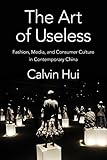The Art of Useless : Fashion, Media, and Consumer Culture in Contemporary China / Calvin Hui.
Material type: TextSeries: Global Chinese CulturePublisher: New York, NY : Columbia University Press, [2021]Copyright date: 2021Description: 1 online resourceContent type:
TextSeries: Global Chinese CulturePublisher: New York, NY : Columbia University Press, [2021]Copyright date: 2021Description: 1 online resourceContent type: - 9780231192484
- 9780231549837
- 306.30951 23
- HC430.C6 H85 2021
- online - DeGruyter
| Item type | Current library | Call number | URL | Status | Notes | Barcode | |
|---|---|---|---|---|---|---|---|
 eBook
eBook
|
Biblioteca "Angelicum" Pont. Univ. S.Tommaso d'Aquino Nuvola online | online - DeGruyter (Browse shelf(Opens below)) | Online access | Not for loan (Accesso limitato) | Accesso per gli utenti autorizzati / Access for authorized users | (dgr)9780231549837 |
Frontmatter -- CONTENTS -- ACKNOWLEDGMENTS -- Introduction. The Trouble with Naming: Middle- Class Culture, Petty- Bourgeois Sensibility, and Zhuang -- Chapter One. Dirty Fashion: Ma Ke’s Fashion Exhibit Useless (2007), Jia Zhangke’s Documentary Film Useless (2007), and Cognitive Mapping -- Chapter Two. The High- Quality Suit, Class Struggle, and Cultural Revolution: The Politics of Consumption in Xie Tieli’s Film Never Forget (1964) -- Chapter Three. “Mao’s Children Are Wearing Fashion!”: Romantic Love, Fashion Consumption, and Modernization Politics in Huang Zumo’s Film Romance on Lu Mountain (1980) -- Chapter Four. Imag(in)ing the Chinese Middle- Class Culture: White- Collar Work, Romantic Love, and Fashion Consumption -- Chapter Five. Between Production and Consumption: Chinese Migrant Factory Workers in Documentary Films and Ethnographic Works -- Chapter Six. The Psychic Life of Rubbish: On Wang Jiuliang’s Documentary Film Beijing Besieged by Waste (2010) -- NOTES -- WORKS CITED -- INDEX
restricted access online access with authorization star
http://purl.org/coar/access_right/c_16ec
Since embarking on economic reforms in 1978, the People’s Republic of China has also undergone a sweeping cultural reorganization, from proletarian culture under Mao to middle-class consumer culture today. Under these circumstances, how has a Chinese middle class come into being, and how has consumerism become the dominant ideology of an avowedly socialist country? The Art of Useless offers an innovative way to understand China’s unprecedented political-economic, social, and cultural transformations, showing how consumer culture helps anticipate, produce, and shape a new middle-class subjectivity.Examining changing representations of the production and consumption of fashion in documentaries and films, Calvin Hui traces how culture contributes to China’s changing social relations through the cultivation of new identities and sensibilities. He explores the commodity chain of fashion on a transnational scale, from production to consumption to disposal, as well as media portrayals of the intersections of clothing with class, gender, and ethnicity. Hui illuminates key cinematic narratives, such as a factory worker’s desire for a high-quality suit in the 1960s, an intellectual’s longing for fashionable clothes in the 1980s, and a white-collar woman’s craving for brand-name commodities in the 2000s. He considers how documentary films depict the undersides of consumption—exploited laborers who fantasize about the products they manufacture as well as the accumulation of waste and its disposal—revealing how global capitalism renders migrant factory workers, scavengers, and garbage invisible.A highly interdisciplinary work that combines theoretical nuance with masterful close analyses, The Art of Useless is an innovative rethinking of the emergence of China’s middle-class consumer culture.
Mode of access: Internet via World Wide Web.
In English.
Description based on online resource; title from PDF title page (publisher's Web site, viewed 26. Aug 2024)


